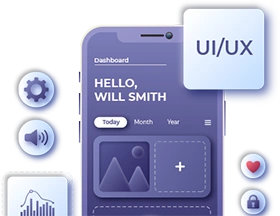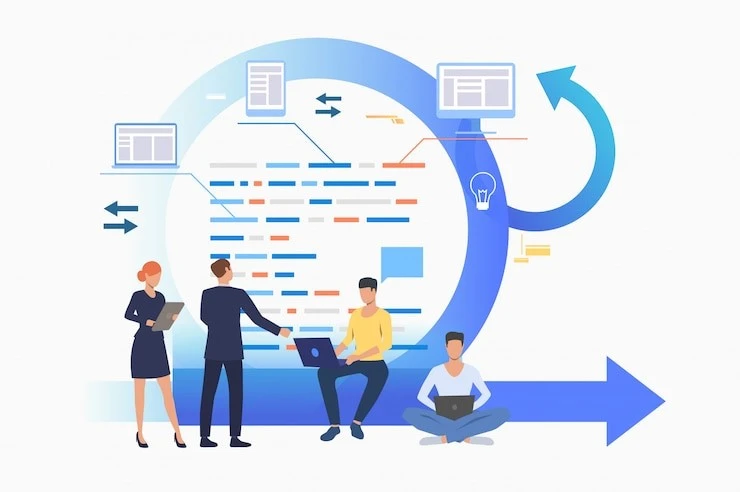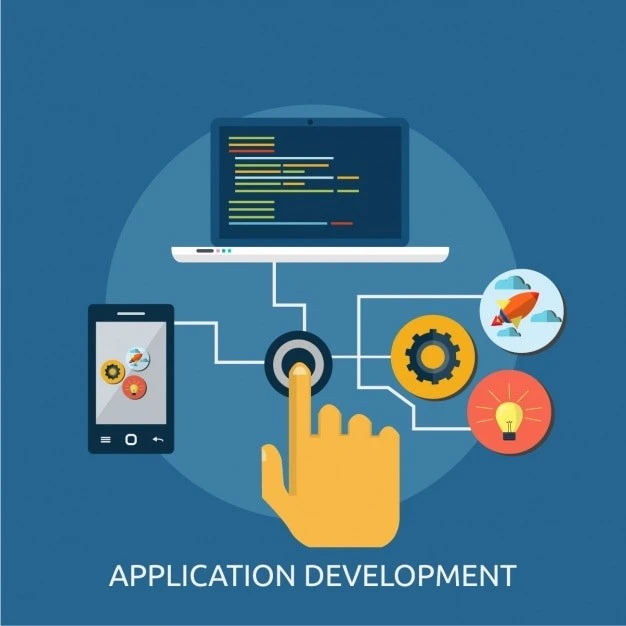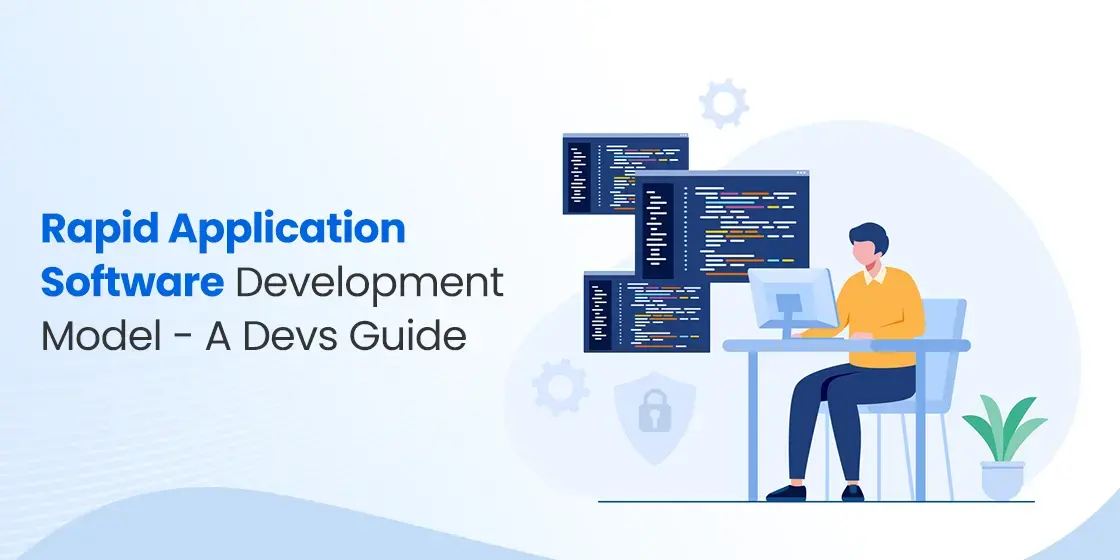Table of Content
Understanding the Ins and Outs of Rapid Application Development
In the world of modern software development, the ability to deliver functional applications quickly and efficiently is paramount. The Rapid Application Development (RAD) model emerged as an alternative to the more traditional, sequential methodologies. And it offered an iterative and agile approach that prioritizes speed and user feedback.
By emphasizing features like the use of pre-built components, RAD aims to significantly reduce development cycles and deliver working software in shorter timeframes. This approach allows organizations to respond more swiftly to changing business needs and market demands, gaining a crucial competitive edge in today’s dynamic environment.
However, the RAD model is not a one-size-fits-all solution, but rather a strategic choice best suited for projects well-defined requirements, UI-focused, and with strong collaboration between all stakeholders. Its focus on iterative development and continuous feedback loops enables greater flexibility and adaptability throughout the development process.
In this guide, we will dive into the core principles and practical steps involved in utilizing the RAD model. We will provide insights for developers looking to leverage its speed and efficiency in their projects, via our experience as a custom software development services provider. Let’s begin.
What is Rapid Application Development (RAD) – A Brief Overview

Rapid Application Development (RAD) is a software development methodology that prioritizes speed and flexibility by emphasizing iterative development and the construction of prototypes. Unlike traditional waterfall models that follow a linear, sequential approach, RAD focuses on quick-build prototypes and gathering user feedback early and often.
This iterative and Agile process allows for greater adaptability to changing requirements and a more collaborative approach between developers and stakeholders. The core philosophy of RAD is to deliver functional software in short cycles, typically using time-boxed iterations, rather than spending extensive time on detailed planning and documentation upfront.
Key characteristics of the RAD model, as well as agile software development, include:
- Heavy user involvement
- Iterative development
- The use of prototypes
- Time-boxing
- Integrated teams
User involvement is crucial throughout the RAD lifecycle, with users actively participating in requirements definition, prototype evaluation, and system testing. Iterative development involves building the software in time-boxed increments, with each iteration resulting in a working prototype that can be reviewed and refined. This allows stakeholders to visualize and interact with the application early in the development process, facilitating better understanding and feedback.
Turn your concepts into mobile apps brimming with advanced features. From inception to deployment, make a distinct impact in the market.
Contact Now
RAD Model Defined
The RAD model typically encompasses four distinct phases:
- Requirements Planning: The Requirements Planning phase involves a high-level overview of the project scope, objectives, and constraints.
- User Design: The User Design phase focuses on creating prototypes based on user input.
- Construction: The Construction phase involves developing the actual application based on the refined prototypes.
- Deployment: The Deployment phase involves deploying the final application and transitioning to operational use.
While these phases provide a general framework, the emphasis in RAD is on speed and flexibility, allowing for overlapping and continuous refinement based on feedback. Rapid Application Development is well-suited for projects where time and user feedback are critical factors.
Why Does an Organization Need Rapid Application Development?

Organizations today operate in a dynamic and competitive environment where the ability to adapt quickly to changing market demands and evolving customer needs is crucial for survival and growth. Rapid Application Development (RAD) offers several compelling advantages for bespoke software development that address these challenges, making it a valuable methodology for many organizations. Some of the primary drivers for adopting RAD include:
- Significantly reduced development time: By focusing on iterative prototyping and minimizing extensive upfront planning, RAD enables organizations to deliver functional applications much faster than traditional methodologies.
- Enhanced user involvement and satisfaction: The continuous feedback loops and the emphasis on prototype evaluation ensure that the final application closely aligns with user needs and expectations. This collaborative approach can lead to higher user satisfaction and a greater likelihood of successful adoption.
- Increased flexibility and adaptability: The ability to quickly build and modify prototypes allows development teams to respond more effectively to changing requirements or unforeseen challenges. By embracing RAD, organizations can gain the agility needed to thrive in today’s rapidly changing business landscape.
Using the Rapid Application Development Model – A Guide to Its Phases

Implementing the Rapid Application Development (RAD) model involves a structured yet flexible approach that emphasizes speed and user collaboration. Here is a guide to utilizing the RAD model effectively.
Defining the Requirements
The initial phase of the RAD model, Requirements Planning, focuses on establishing a high-level understanding of the project scope, objectives, and constraints. Unlike traditional methodologies that require upfront requirements documentation, RAD emphasizes capturing the essential business needs and user expectations through workshops, focus groups, and interviews.
The goal is to define the core functionalities and features that will be included in the initial prototypes. This phase involves identifying key stakeholders, understanding their business goals, and outlining the major deliverables and timelines. While not as detailed as traditional requirements gathering, this phase is crucial for setting the overall direction of the project and ensuring that all stakeholders have a shared understanding of the objectives.
The emphasis is on speed and collaboration to quickly establish a foundational understanding that will guide the subsequent prototyping efforts.
Create Prototypes
The User Design phase is the heart of the RAD model. In this stage, the focus shifts to creating working prototypes of the application based on the high-level requirements gathered in the previous phase. These prototypes are not to be fully functional but rather provide a visual representation of the user interface and key functionalities, allowing users to interact with it early in the development process.
The emphasis is on rapid development and iterative refinement of the prototype based on continuous feedback from users. Multiple iterations of the prototypes may be created and revised based on user feedback, ensuring that the final application aligns closely with their needs and expectations. This iterative feedback loop is crucial for identifying and addressing usability issues and requirement gaps early in the development cycle, minimizing costly rework later on.
System Construction
Once the prototypes have been approved by the users, the project moves into the Construction phase. Here, developers focus on building the actual working application based on the finalized prototypes and design specifications. This phase involves coding, unit testing, integration testing, and system testing.
While the prototypes provide a blueprint for the application, the construction phase involves building the underlying logic, database structures, and integrations with other systems. The emphasis remains on speed and efficiency, often leveraging the prototypes as a basis for incremental development. The use of pre-built components, code generation tools, and IDEs can further accelerate the development process.
Continuous integration is often used to ensure that different parts of the system work together seamlessly. Regular communication and collaboration within the development team are essential to ensure that the application is built according to the agreed-upon specifications and that any issues are addressed promptly. While speed is a priority, quality and adherence to the refined requirements remain critical during this phase, as well as robustness for issues such as software migration.
Application Deployment
The final phase of the RAD model is the Deployment phase. This involves deploying the completed application into the production environment and transitioning users to the new system. This phase includes final testing, user training, data conversion (if necessary), and the actual rollout of the application.
Unlike traditional “big bang” deployments, RAD often favors a phased deployment approach, where different parts of the system are rolled out incrementally. This allows for a smoother transition and provides an opportunity to gather feedback on the deployed modules and make adjustments as needed. The focus during deployment is on minimizing disruption to business operations and ensuring a successful transition to the new system.
Rapid Application Development Benefits

The Rapid Application Development model offers several significant benefits (and cons) that make it a great choice for many software development projects. One of the most prominent advantages is the accelerated development lifecycle. Using iterative development, RAD significantly reduces the time required to deliver a functional application compared to traditional waterfall methodologies.
Some of its core benefits include:
- Faster time-to-market
- Enhanced user involvement and higher user satisfaction
- Increased flexibility and adaptability
FAQs
| What are the five phases of the expanded RAD framework? The five phases of the expanded RAD model include: Business modelling Data modelling Prototyping Construction Testing and Deployment |
| What is the difference between RAD and agile? RAD follows the core tenets of agility in that it focuses on iterative development and continuous feedback. However, while core agile is all about identifying change flexibly, RAD focuses on quick pivoting and embracing innovation. |
| Is RAD similar to agile? Yes, based on their core tenets, RAD and agile are quite similar in that they both focus on quick adaptation, iterative development, and feedback loops. |
Conclusion
The Rapid Application Development model offers an interesting alternative to traditional software development methodologies, prioritizing speed, flexibility, and user collaboration. RAD enables development teams to deliver functional applications in significantly shorter timeframes, allowing organizations to respond swiftly to evolving business needs and market demands.
While RAD may not be suitable for all types of projects, particularly those with highly complex or unstable requirements, its emphasis on rapid delivery and adaptability makes it a valuable approach for many organizations seeking to gain a competitive edge in today’s dynamic environment.
By understanding and effectively implementing the principles and steps of the RAD model, development teams can leverage its power to deliver high-quality software quickly and efficiently, ultimately driving greater business value.
Empower your digital initiatives with BariTechSol, a premier custom software development company. Our skilled team tailors cutting-edge solutions to your unique needs. Elevate your tech experience and stay ahead in the digital realm. Partner with BaritechSol and code the success of your next big idea.


